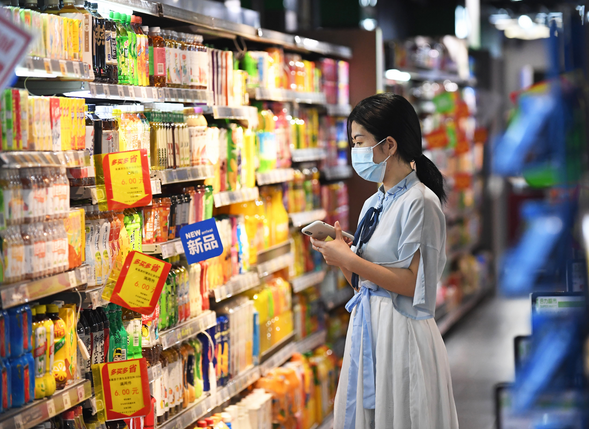BEIJING, June 24 (Xinhua) -- After grappling with lingering COVID-19 for months, China's retail sales sector is gaining steam in its recovery, with fuel added by the government's supportive policies and digital technologies.
The country's retail sales of consumer goods went down 6.7 percent from a year ago in May, narrowing by 4.4 percentage points from April, data from the National Bureau of Statistics (NBS) showed.
"The recovery of consumption will pick up pace as people's lives return to normal," said NBS spokesperson Fu Linghui, attributing the smaller decline to the improving epidemic situation and business activities, as well as policies to spur consumption.
On a brighter note, online consumption continued to shore up retail sales. In the first five months, online sales of physical goods climbed 5.6 percent, with its proportion of retail sales increasing.
Analysts believe that the recent arrangements by authorities to tide retailers over difficulties and their own efforts to ride the digitalization wave will further unleash the potential of consumption, providing a solid foundation for high-quality development.
POLICIES OFFER HOPE
"Thanks to the shopping vouchers released by e-commerce platforms, our online sales have registered an over 250-percent year-on-year growth since June," said Song Huasong, regional president of Lotus supermarkets in central China's Hunan Province.
The company's experience offers a glimpse of China's massive voucher giveaway to boost spending when the Omicron outbreak weighed heavily on domestic consumption.
Zhengzhou, capital city of Henan Province, plans to distribute vouchers worth 240 million yuan (about 35.82 million U.S. dollars) from late May to the end of August to encourage local spending in various sectors such as automobiles, catering and tourism.
Meanwhile, Hainan Province, which is striving to become the country's largest free trade port, granted 20 million yuan of vouchers to boost offshore duty-free shopping. Chengdu city decided to give out 160 million yuan of coupons in the form of digital yuan.
Besides issuing consumption vouchers to stimulate consumer demand instantly, China also encouraged local governments to cut taxes and fees for retailers, as well as offer subsidies for enterprises' epidemic prevention and disinfection.
"Policy support can improve the consumption capacity and ease burden for enterprises, thus the market can expect a stepped-up rebound," said Chen Lifen, a researcher with the Development Research Center of the State Council, suggesting efforts to accelerate the implementation of preferential policies.
DIGITALIZATION INJECTS IMPETUS
While enjoying preferential policies, many retailers of physical goods, bearing the brunt of the epidemic, have devised ways of digital transformation to turn the tide against the virus.
Intime Department Store saw over 6,000 of its shopping guides become retail livestreamers and the volume of livestreaming sales surged by 2.7 times in May, according to the company.
The company has established mini "cloud stores" in more than 20 Chinese cities, usually lower-tier ones. Consumers can select commodities with the help of shopping guides via digital platforms and try samples in the store, which improved their shopping experience.
"Efforts should be made to step up the integrated development of online and offline shopping, and nurture new consumption trends like customization and experiential shopping," said Vice Minister of Commerce Sheng Qiuping.
Since the beginning of the COVID-19 resurgence, many e-commerce platforms have pooled their resources along the supply chain, including nationwide warehouse networks and internet traffic, to expand sales for the struggling small and medium-sized firms.
Digital capabilities of e-commerce platforms can help free small businesses from constraints in financing, technology, marketing and human resources, thus improving supply quality and promoting consumption upgrade, said Zhao Ping, vice president of the Academy of China Council for the Promotion of International Trade.




 A single purchase
A single purchase









